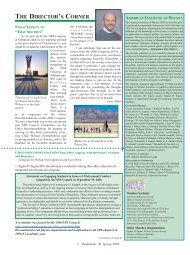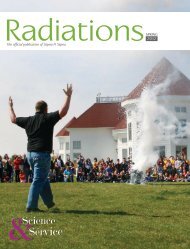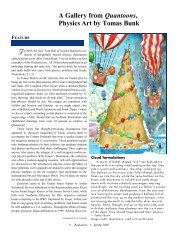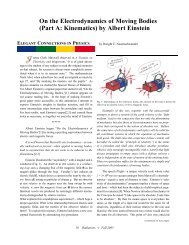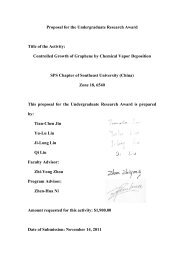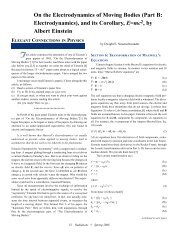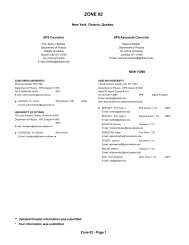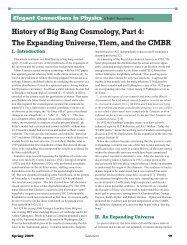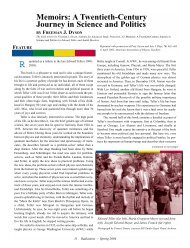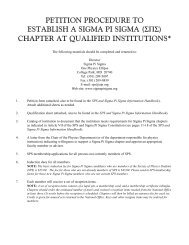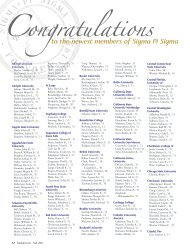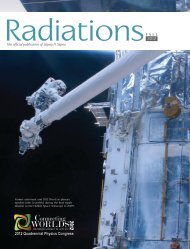Download a PDF of the entire issue - Sigma Pi Sigma
Download a PDF of the entire issue - Sigma Pi Sigma
Download a PDF of the entire issue - Sigma Pi Sigma
Create successful ePaper yourself
Turn your PDF publications into a flip-book with our unique Google optimized e-Paper software.
Society News<br />
My Summer with Ru<strong>the</strong>rford<br />
by Erin Grace, 2011 SPS Intern<br />
You might say I spent this<br />
summer with Ernest Ru<strong>the</strong>rford,<br />
and in <strong>the</strong> process<br />
I learned everything from<br />
scientific modeling to how to<br />
set a mousetrap. How did I<br />
become so closely acquainted<br />
with <strong>the</strong> discoverer <strong>of</strong> <strong>the</strong><br />
atomic nucleus? Well, I was<br />
one <strong>of</strong> this year’s crop <strong>of</strong><br />
Society <strong>of</strong> Physics Students<br />
(SPS) summer interns. Toge<strong>the</strong>r<br />
with my fellow intern,<br />
Amanda Palchak, we created<br />
<strong>the</strong> 2011 Science Outreach<br />
Catalyst Kit (SOCK). These<br />
kits contain materials for outreach<br />
activities and are free to<br />
university SPS chapters that<br />
request <strong>the</strong>m. This year’s<br />
<strong>the</strong>me, “A Century <strong>of</strong> Revolution,”<br />
celebrates one hundred<br />
years since Ru<strong>the</strong>rford’s discovery<br />
<strong>of</strong> <strong>the</strong> nucleus based<br />
on <strong>the</strong> gold foil experiment.<br />
Initially, <strong>the</strong> prospect <strong>of</strong><br />
creating a lesson on Ru<strong>the</strong>rford<br />
scattering for elementary<br />
school students was pretty<br />
daunting. But Gary White,<br />
our summer mentor, helped<br />
us tease out <strong>the</strong> fundamental<br />
ideas behind <strong>the</strong> gold foil<br />
experiment that could be<br />
taught to elementary through<br />
high school students. For<br />
example, Ru<strong>the</strong>rford used an<br />
analysis <strong>of</strong> elastic collisions<br />
to interpret <strong>the</strong> deflection <strong>of</strong><br />
alpha particles at large angles.<br />
To teach this central concept<br />
<strong>of</strong> collisions, we created an<br />
activity in which students roll<br />
a ball down a Hot Wheels<br />
track so that it collides with a<br />
stationary ball at <strong>the</strong> bottom.<br />
By experimenting with different<br />
balls, students formulate<br />
a relationship between <strong>the</strong><br />
6 Radiations Fall 2011<br />
Erin Grace is in her senior year<br />
as a physics education major<br />
and math minor at <strong>the</strong> University<br />
<strong>of</strong> Delaware. Originally<br />
from Cincinnati, OH, she will<br />
begin student teaching in <strong>the</strong><br />
spring <strong>of</strong> 2012. After graduating,<br />
she plans to be a high<br />
school physics teacher. As an<br />
undergraduate, she has done<br />
a lot <strong>of</strong> individual and group<br />
tutoring in math and physics.<br />
She loves to help students have<br />
those “Aha!” moments where<br />
something clicks for <strong>the</strong>m.<br />
ABOVE<br />
The Mystery Box demonstration based on Ru<strong>the</strong>rford’s gold foil<br />
experiment from <strong>the</strong> 2011 SPS SOCK (Science Outreach Catalyst<br />
Kit). Photos by Tracy Schwab.<br />
For more information on <strong>the</strong> SOCK program, visit:<br />
www.spsnational.org/programs/socks/.<br />
For more information on <strong>the</strong> SPS Internship program, visit:<br />
www.spsnational.org/programs/internships/.<br />
relative masses and <strong>the</strong> directions<br />
<strong>the</strong> balls go after <strong>the</strong><br />
collision. Students learn that<br />
when a heavy object hits a<br />
light object, both continue in<br />
<strong>the</strong> original direction <strong>of</strong> motion,<br />
but when a light object<br />
hits a heavy object, <strong>the</strong> light<br />
object bounces back while <strong>the</strong><br />
heavy object travels forward.<br />
At <strong>the</strong> end <strong>of</strong> <strong>the</strong> lesson,<br />
students apply <strong>the</strong>ir new<br />
understanding <strong>of</strong> collisions<br />
to help solve a gold robbery<br />
mystery. When we tried <strong>the</strong><br />
lesson with a 3rd grade class,<br />
I felt ecstatic to see all 30<br />
hands waving desperately in<br />
<strong>the</strong> air to reveal <strong>the</strong> solution<br />
to <strong>the</strong> mystery.<br />
I also learned about how<br />
useful models can be in<br />
teaching physics. For our<br />
second activity, we created a<br />
model <strong>of</strong> <strong>the</strong> gold foil experiment.<br />
In this “Mystery Box”<br />
activity, students roll marbles<br />
down a ramp into a box.<br />
The box has a mystery item<br />
inside that students attempt<br />
to identify by observing<br />
<strong>the</strong> direction in which <strong>the</strong><br />
marbles exit <strong>the</strong> box. The<br />
marbles’ directions, like <strong>the</strong><br />
direction <strong>of</strong> deflected alpha<br />
particles, are evidence <strong>of</strong><br />
what is inside <strong>the</strong> box (i.e.<br />
gold atoms). While <strong>the</strong><br />
model is not perfect, interacting<br />
with <strong>the</strong> boxes helped <strong>the</strong><br />
students to understand not<br />
just <strong>the</strong> results <strong>of</strong> <strong>the</strong> gold foil<br />
experiment, but <strong>the</strong> thought<br />
process behind Ru<strong>the</strong>rford’s<br />
breakthrough.<br />
One surprising skill I<br />
picked up this summer was<br />
setting a mousetrap. For our<br />
third lesson, we demonstrated<br />
a chain reaction, like those<br />
in nuclear reactors, with<br />
mousetraps and ping pong<br />
balls. We laid out a grid <strong>of</strong><br />
mousetraps with ping pong<br />
balls perched on top, and<br />
<strong>the</strong>n threw in an extra ping<br />
pong ball. Then snap… snapsnap…<br />
SNAPSNAPSNAP-<br />
SNAP – <strong>the</strong>y all went <strong>of</strong>f in<br />
a spectacular chain reaction.<br />
From this we created a video<br />
to use in <strong>the</strong> classroom. See<br />
<strong>the</strong> SPS National YouTube<br />
channel: www.youtube.com/<br />
user/SPSnational .<br />
Perhaps <strong>the</strong> biggest thing<br />
I learned this summer was <strong>the</strong><br />
power <strong>of</strong> collaboration. Ru<strong>the</strong>rford<br />
himself was a master <strong>of</strong><br />
collaboration, as he was a key<br />
continued on page 37



